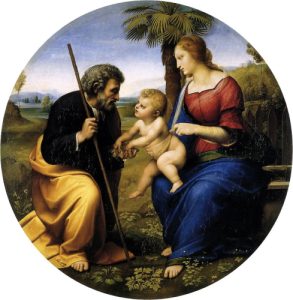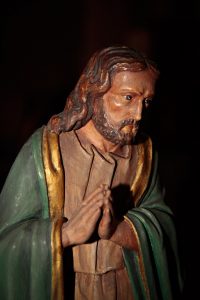Tis the season when many of us are singing – and/or listening to – Christmas carols. These carols often reflect the stories of Jesus’ birth as recounted in the New (Christian) Testament Gospels of Matthew and Luke, but many others originate considerably later in the Christian tradition.
One of these later tales is the Cherry Tree Carol, the history of which demonstrates how the Jesus story has evolved and been used by different communities for various purposes over several centuries. In Matthew 2, after Jesus’ birth in Bethlehem, the jealous, insecure and cruel King Herod orders all male children under two years of age murdered. Joseph, Mary’s betrothed, has been warned in a dream that this is coming, so he, Mary and Jesus flee to Egypt.
The Gospel of Pseudo-Matthew, a popular non-canonical work composed in the 8th or 9th century (Cartlidge and Elliott, 3), picks up on the tale, relying heavily on the Protevangelium of James and Infancy Thomas, two other apocryphal works. Pseudo-Matthew 20 relates that, on the third day of the journey, Mary grows fatigued by the heat of the day and asks to rest under the branches of a nearby palm tree. She sees that the tree is full of dates and asks Joseph to get some for her, but the tree is too high. Joseph in fact chastises her and argues that it would be better to find water for themselves and their cattle.  At this point, the baby Jesus – sitting on Mary’s lap – commands the tree to bend down so that Mary can reach the fruit. The “palm bent its top down to the very feet of Mary; and they gathered from it fruit with which they all refreshed themselves.” The tree then waits for Jesus to command it to straighten up and “open from your roots a vein of water which is hidden in the earth and let the waters flow, so that we may quench our thirst.” The tree obeys, and water gushes out clear, cool water from its root. There is great rejoicing by all the humans and animals, and they offer thanks to God.
At this point, the baby Jesus – sitting on Mary’s lap – commands the tree to bend down so that Mary can reach the fruit. The “palm bent its top down to the very feet of Mary; and they gathered from it fruit with which they all refreshed themselves.” The tree then waits for Jesus to command it to straighten up and “open from your roots a vein of water which is hidden in the earth and let the waters flow, so that we may quench our thirst.” The tree obeys, and water gushes out clear, cool water from its root. There is great rejoicing by all the humans and animals, and they offer thanks to God.
The story eventually evolved into the Cherry Tree Carol. While there are a number of versions, one in particular appeared in the ‘N-Town Plays,’ Bible-based mystery plays or pageants that were performed in the English Midlands around 1500. The date-palm tree has changed to a cherry tree in the text because palm trees were rare in England (Cartlidge and Elliott, 100). In this version of the carol, though, contrary to the story in Pseudo-Matthew where Jesus has already been born, Mary is pregnant, and Jesus commands the tree from inside her womb:
And Mary spoke to Joseph, so meek and so mild
“Joseph, gather me some cherries for I am with child”
“Joseph, gather me some cherries for I am with child”
Joseph is furious, believing that Mary has become pregnant by another man:
And Joseph flew in anger, in anger flew he
“Let the father of the baby gather cherries for thee”
“Let the father of the baby gather cherries for thee”
This part of the story is reflected (though less harshly) in Matt 1:18-25 when Joseph discovers Mary’s pregnancy even though he has not been with her. Joseph, “being a righteous man,” decides to “put her away secretly.” However, an angel appears to Joseph in a dream, tells him that the child has been conceived by the Holy Spirit and assures him that he can legitimately take Mary as his wife.
The carol then picks up this part of the Pseudo-Matthew story:
Then up spoke baby Jesus, from in Mary’s womb
“Bend down the tallest tree that my mother might have some”
“Bend down the tallest tree that my mother might have some”
And bend down the tallest branch till it touched Mary’s hand
Cried she, “Oh, look thou Joseph, I have cherries by command”
Cried she, “Oh, look thou Joseph, I have cherries by command”
Pseudo-Matthew 20 goes on to expound on the palm-tree theme.  Jesus speaks to the tree and tells it that one of its branches will be carried away by angels into paradise. Jesus confers a blessing on the branch, “that it shall be said to all who shall be victorious in any contest, ‘You have attained the palm of victory.’” An angel appears, takes a branch off the tree, and flies away with it. The people who witness this are filled with fear, but Jesus allays their fears by telling them that the palm that is now in paradise will be prepared for “all the saints in the place of blessedness,” and the people rejoice. In Christian iconic art over the centuries, the image of a figure holding a palm branch symbolizes that person’s victory (Cartlidge and Elliott, 101-02).
Jesus speaks to the tree and tells it that one of its branches will be carried away by angels into paradise. Jesus confers a blessing on the branch, “that it shall be said to all who shall be victorious in any contest, ‘You have attained the palm of victory.’” An angel appears, takes a branch off the tree, and flies away with it. The people who witness this are filled with fear, but Jesus allays their fears by telling them that the palm that is now in paradise will be prepared for “all the saints in the place of blessedness,” and the people rejoice. In Christian iconic art over the centuries, the image of a figure holding a palm branch symbolizes that person’s victory (Cartlidge and Elliott, 101-02).
The history of the Cherry Tree Carol illustrates several aspects of the development of Christianity.
- The canonical texts about Jesus and the Jesus movement – the texts that were accepted as fairly authoritative throughout the early Roman Empire – were not composed as history in our Post-Enlightenment understanding. Some of the stories told in the canonical texts that depict the same event actually display significant differences. Our modern mind wants to resolve those differences and create a harmonized version. When dealing with these stories, we need not harmonize them; rather, we can appreciate that the authors often started with the same kernel of a story and told it in different ways in and for different communities.
- Christian literature that did not make it into the “canon,” written decades and even centuries after the time of the earliest disciples, contains stories that are often quite fanciful, sometimes taking an established text and embellishing it for various theological and educational purposes. The new tales have become part of our beloved traditions.
- As we saw earlier, the tales about Jesus could be startling and even humorous. They offer us windows into how early Christians regarded the life of the man whom they considered their Lord and Savior.
- Both the canonical and extra-canonical texts have been set to music and been featured in works of visual art and theater for over a millennia, and we still appreciate them today.
- It is not necessary to believe the stories as factual in order to enjoy them and even, at times, to acknowledge their power to inspire and enlighten us.
Happy holidays!
Resources
Cartlidge, David R. and J. Keith Elliott. Art and the Christian Apocrypha. London and New York: Routledge, 2001.
Cherry Tree Carol, Joan Baez version:
When Joseph was an old man, an old man was he
He married Virgin Mary, the queen of Galilee
He married Virgin Mary, the queen of Galilee
Joseph and Mary walked through an orchard green
There were berries and cherries, as thick as might be seen
There were berries and cherries, as thick as might be seen
And Mary spoke to Joseph, so meek and so mild
“Joseph, gather me some cherries for I am with child”
“Joseph, gather me some cherries for I am with child”
And Joseph flew in anger, in anger flew he
“Let the father of the baby gather cherries for thee”
“Let the father of the baby gather cherries for thee”
Then up spoke baby Jesus, from in Mary’s womb
“Bend down the tallest tree that my mother might have some”
“Bend down the tallest tree that my mother might have some”
And bend down the tallest branch till it touched Mary’s hand
Cried she, “Oh, look thou Joseph, I have cherries by command”
Cried she, “Oh, look thou Joseph, I have cherries by command”
Leith, Mary Joan Winn. “The Origins of “The Cherry Tree Carol,” Bible History Daily, Biblical Archaeology Society, Dec. 2, 2018.

